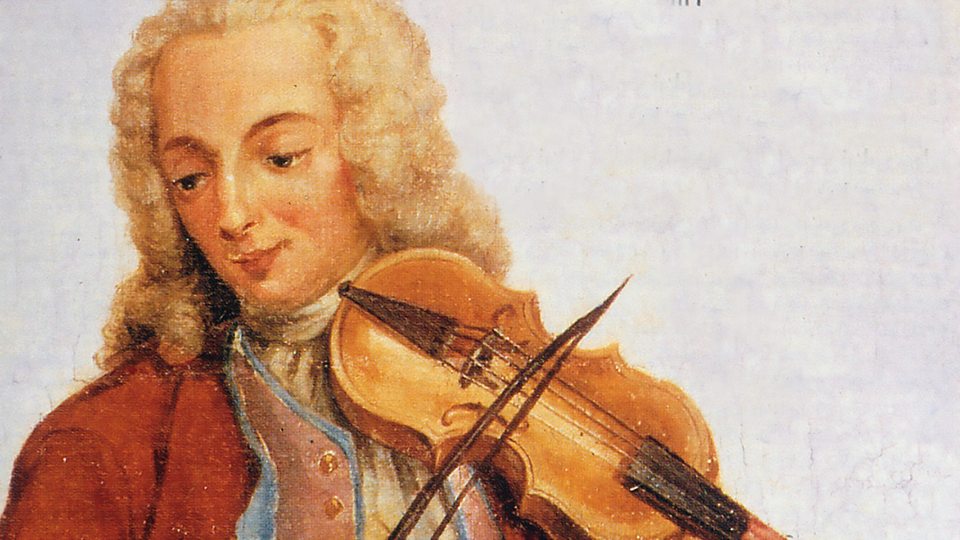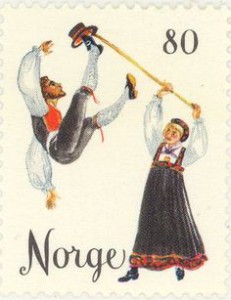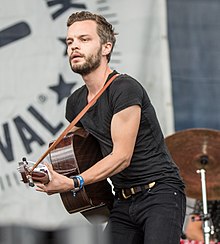For a long time, music in Sweden tended to be a hodgepodge of northern European musical styles: mazurka (Poland), polka (Bohemia and Czech), schottische (Bohemia), waltz (Germany), and the polska (Nordic music and dance). Music has long played an important part of their culture, leading up to having quite a few internationally successful commercial acts.
Folk songs were generally derived from herding songs from the fields. Two main types of folk songs developed in Sweden: kuhling, a type of song sung by women engaged in cow-herding; and ballad songs that stemmed from a printed sheet of poetry called skillingtryck that was popular during the 19th century.
 |
| Johan Helmich Roman - I don't know about you, but that bow looks like it doubles as a bayonet. |
While countries like Germany, France, England, Austria, Italy, and Russia had classical composers that are far more well known, Sweden wasn’t completely left out of the game. They were just known on a smaller scale. Johan Helmich Roman was one of the earliest composers to have any kind of influence on the classical music scene in Sweden, often referred to as the “father of Swedish classical music.” Joseph Martin Kraus was another composer during the Classical period who was quite well known in Sweden. The Romantic period brought about several composers, many of whom who incorporated Norse mythology and folk songs into their music: Franz Berwald and Wilhelm Stenhammar. Composers like Kurt Magnus Atterberg, Hilding Rosenberg, and Ture Rangström flourished during the 20th century. Talented opera singers and musicians traveled the world showing off what they do best, and chorale singing was pushed as a genre that became quite popular in Sweden and making a name for itself.
Much of the folk music styles have corresponding dances that go with them and are similar to folk dances/music throughout the Nordic region (Norway, Denmark, Sweden, Finland). And many of these dances originated elsewhere. The larger portion of these types of dances are partner dances, although there are quite a few exceptions to this. One example is the halling dance, a type of solo dance from Norway that’s also danced in some areas of Sweden. From what I've gathered, it looks like you have to kick a hat on a pole. Winters are long in these parts, I suppose.
 |
| Although this is a Norwegian stamp, you can see what halling is. |
By far, the most common instrument used in Swedish folk music is the fiddle. Essentially the fiddle and the violin are the same instrument although the style of playing is different, and there might be some variations in construction in order to produce the sound they’re looking for. And of course, there were variations of the fiddle as well: the låtfiol (a type of fiddle with two sympathetic strings) and the nyckelharpa (a keyed fiddle, like a cross between a fiddle and a hurdy-gurdy). I usually think of the bagpipes as being a Scots-Irish instrument, but it’s also used in other cultures including Swedish folk music along with harmonicas and accordions.
 |
| Nyckelharpa |
So apparently, unbeknownst to me, there are a ton of bands and artists that originated from Sweden. (And almost all of them sing in English.) I’ve been so busy lately, that I didn’t really get to dig into all of the artists I’m not familiar with, so here’s a short recap of the ones I mainly already knew (who may be new to you!).
 |
| ABBA |
Probably the most well known Swedish band in the world is none other than Anthony Bourdain’s nemesis: ABBA. Super popular in the 1970s and 1980s, they’re almost synonymous to the disco era of music. Two of their members, Benny Andersson and Björn Ulvaeus along with lyricist Tim Rice, created the cold war musical Chess in 1984 (which I bought a copy of as a teenager!). Much of their music was also used in the movie musical Mamma Mia! (which I have not seen).
 |
| Europe |
The band Europe, known for their song “The Final Countdown,” got their start in 1979 and continued up to the early 1990s. To me, they had that “hair band” sound and were influenced by quite a few similar acts.
 |
| Roxette |
Another band I remember listening to when I was in middle school was Roxette. I used to love the song “Fading Like a Flower.” However, when I listened to the song “Spending My Time,” it sounded familiar to me but not exactly. Then it hit me: I knew this song from a mostly unlabeled CD of Spanish-language songs someone had given me years ago, and this song was under the title “Un Dia Sin Ti.”
 |
| Ace of Base |
And of course, I had several Ace of Base songs on high rotation back in the day. It was one of the handful of bands at that time who were helping to bring this style of dance music into the US mainstream radio play. I’d say most people are familiar with their songs “The Sign,” “All That She Wants,” and “Don’t Turn Around.”
 |
| Eagle Eye Cherry |
And one of the biggest surprises for me was finding out Eagle Eye Cherry was Swedish. I really liked the song “Save Tonight” when it first came out, and I finally listened to more of their stuff and was pleased to find out it’s mostly in the same style.
 |
| The Cardigans - clearly she's not wearing one |
OK, now when I was in high school, our Japanese foreign exchange student introduced me to The Cardigans, and I was obsessed with them for several years. I knew the lyrics to all the songs from the The Band on the Moon album. The song “Lovefool” was made popular for being on the Romeo + Juliet soundtrack.
 |
| Peter Bjorn and John |
Now for indie rock: I knew about Peter Bjorn and John for a while, ever since their song “Young Folks” was used in an AT&T Mobile Music commercial way back in the day. It’s been used in several other commercials since then, and one oddly named “Hey Google, play that hipster song with the whistles.” That narrows it down to like 1462 songs.
 |
| Avicii -- RIP |
Avicii has been popular in dance clubs and video games alike. His songs “Levels,” “Hey Brother,” and “Wake Me Up” are probably the most known songs. He unfortunately passed away a last year at the age of 28 from suicide.
 |
| Swedish House Mafia |
Sticking to the same genre, Swedish House Mafia has had quite a bit of success in the dance/club music and video game music. The songs “Antidote,” “One,” and “Save the World” are probably some of the more recognizable songs.
 |
| The Tallest Man on Earth - maybe on the inside, probably average in real life |
My cousin’s wife introduced me to The Tallest Man on Earth (not literally, although that would be cool). I could’ve sworn he was probably from Tennessee or something and was super surprised to find out he wasn’t. His mostly acoustic guitar folk melodies always put me in a retrospective mood, like I need a frosty morning and a cup of hot coffee and a blanket.
 |
| Tove Lo |
In the pop music genre, one artist who was pretty popular a few years ago is Tove Lo. I haven’t heard much from her in the last couple of years ago. But her songs “Habits (Stay High)” and “Talking Body” were played all the time on the radio there for a minute. Her birthday is the day after mine, by the way.
 |
| Opeth |
In Swedish music that I wasn’t fully aware of before this, I came across one in the swing hip-hop category that I listened to called Movits!, and a few in various rock and metal categories: Dark Tranquility, Yngwie Malmsteen (who I knew of), and Opeth (who I also knew of).
Up next: the food
















No comments:
Post a Comment